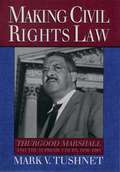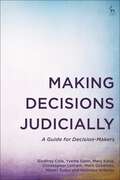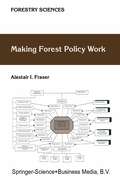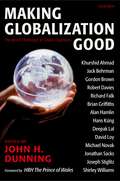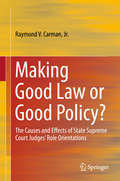- Table View
- List View
Making China Strong: The Role of Nationalism in Chinese Thinking on Democracy and Human Rights (Politics and Development of Contemporary China)
by R. WeatherleyRobert Weatherley argues that Chinese perceptions of democracy and human rights have been heavily influenced by the pressing issue of how to make China strong in the face of a perceived threat posed by foreign imperialism, be it military imperialism during the previous two centuries and cultural imperialism in more recent decades.
Making Citizens: Public Rituals and Personal Journeys to Citizenship (Palgrave Politics of Identity and Citizenship Series)
by Bridget ByrneIn an increasingly mobile world with mounting concerns about the states' control of borders and migration, passports and citizenship rights matter more than ever. This book asks what citizenship ceremonies can tell us about how citizenship is understood through empirical research in the UK, the USA, Canada, Australia, the Netherlands and Ireland.
Making Civil Rights Law: Thurgood Marshall And The Supreme Court, 1936-1961
by Mark V. TushnetFrom the 1930s to the early 1960s civil rights law was made primarily through constitutional litigation. Before Rosa Parks could ignite a Montgomery Bus Boycott, the Supreme Court had to strike down the Alabama law which made segregated bus service required by law; before Martin Luther King could march on Selma to register voters, the Supreme Court had to find unconstitutional the Southern Democratic Party's exclusion of African-Americans; and before the March on Washington and the Civil Rights Act of 1964, the Supreme Court had to strike down the laws allowing for the segregation of public graduate schools, colleges, high schools, and grade schools. Making Civil Rights Law provides a chronological narrative history of the legal struggle, led by Thurgood Marshall and the NAACP Legal Defense Fund, that preceded the political battles for civil rights. Drawing on interviews with Thurgood Marshall and other NAACP lawyers, as well as new information about the private deliberations of the Supreme Court, Tushnet tells the dramatic story of how the NAACP Legal Defense Fund led the Court to use the Constitution as an instrument of liberty and justice for all African-Americans. He also offers new insights into how the justices argued among themselves about the historic changes they were to make in American society. Making Civil Rights Law provides an overall picture of the forces involved in civil rights litigation, bringing clarity to the legal reasoning that animated this "Constitutional revolution", and showing how the slow development of doctrine and precedent reflected the overall legal strategy of Thurgood Marshall and the NAACP.
Making Civil Rights Law: Thurgood Marshall and the Supreme Court, 1936-1961
by Mark V. TushnetFrom the 1930s to the early 1960s civil rights law was made primarily through constitutional litigation. Before Rosa Parks could ignite a Montgomery Bus Boycott, the Supreme Court had to strike down the Alabama law which made segregated bus service required by law; before Martin Luther King could march on Selma to register voters, the Supreme Court had to find unconstitutional the Southern Democratic Party's exclusion of African-Americans; and before the March on Washington and the Civil Rights Act of 1964, the Supreme Court had to strike down the laws allowing for the segregation of public graduate schools, colleges, high schools, and grade schools. Making Civil Rights Law provides a chronological narrative history of the legal struggle, led by Thurgood Marshall and the NAACP Legal Defense Fund, that preceded the political battles for civil rights. Drawing on interviews with Thurgood Marshall and other NAACP lawyers, as well as new information about the private deliberations of the Supreme Court, Tushnet tells the dramatic story of how the NAACP Legal Defense Fund led the Court to use the Constitution as an instrument of liberty and justice for all African-Americans. He also offers new insights into how the justices argued among themselves about the historic changes they were to make in American society. Making Civil Rights Law provides an overall picture of the forces involved in civil rights litigation, bringing clarity to the legal reasoning that animated this "Constitutional revolution", and showing how the slow development of doctrine and precedent reflected the overall legal strategy of Thurgood Marshall and the NAACP.
Making CO2 a Resource: The Interplay Between Research, Innovation and Industry (Routledge Explorations in Environmental Studies)
by Elin M. Oftedal Øyvind StokkeThis interdisciplinary book explores how CO2 can become a resource instead of a waste and, as such, be a tool to meet one of the grandest challenges humanity is facing: climate change.Drawing on a Norwegian narrative that has significance for a global audience, Øyvind Stokke and Elin Oftedal introduce in-depth, multi-perspective analyses of a sustainable innovation research experiment in industrial carbon capture and utilisation technologies. Building on extensive literature within marine sciences, sustainability research, and environmental philosophy and ethics, this book documents how a misplaced resource like CO2 can become valuable within a circular economy in its own right, while at the same time meeting the challenge of food security in a world where food production is increasingly under pressure. The book is diverse in scope and includes chapters on how to reduce the environmental footprint of aquaculture by replacing wild fish and soy from the Amazon, how to optimise the monitoring of aquatic environments via smart technologies, and how to replace materials otherwise sourced from natural environments. The authors also analyse the pivotal role of the university in driving innovation and entrepreneurship, the pitfalls of different carbon technologies, and explore how the link between petroleum dependence and CO2 emissions has been addressed in Norway specifically.Making CO2 a Resource will be of great interest to students and scholars of climate change, environmental ethics, environmental philosophy, sustainable business and innovation, and sustainable development more broadly.
Making CO2 a Resource: The Interplay Between Research, Innovation and Industry (Routledge Explorations in Environmental Studies)
This interdisciplinary book explores how CO2 can become a resource instead of a waste and, as such, be a tool to meet one of the grandest challenges humanity is facing: climate change.Drawing on a Norwegian narrative that has significance for a global audience, Øyvind Stokke and Elin Oftedal introduce in-depth, multi-perspective analyses of a sustainable innovation research experiment in industrial carbon capture and utilisation technologies. Building on extensive literature within marine sciences, sustainability research, and environmental philosophy and ethics, this book documents how a misplaced resource like CO2 can become valuable within a circular economy in its own right, while at the same time meeting the challenge of food security in a world where food production is increasingly under pressure. The book is diverse in scope and includes chapters on how to reduce the environmental footprint of aquaculture by replacing wild fish and soy from the Amazon, how to optimise the monitoring of aquatic environments via smart technologies, and how to replace materials otherwise sourced from natural environments. The authors also analyse the pivotal role of the university in driving innovation and entrepreneurship, the pitfalls of different carbon technologies, and explore how the link between petroleum dependence and CO2 emissions has been addressed in Norway specifically.Making CO2 a Resource will be of great interest to students and scholars of climate change, environmental ethics, environmental philosophy, sustainable business and innovation, and sustainable development more broadly.
Making Connections: The Long-Distance Bus Industry in the USA (The Dynamics of Economic Space)
by Margaret WalshThis book argues that legal persuasion results from making and breaking mental connections. To support this argument, it follows a cognitive science roadmap while the authors road test the directions through rhetorical analysis. By taking a rhetorical approach to persuasion, the authors are able to integrate research from cognitive science with classical and contemporary rhetorical theory, and then to apply both to the taking apart and the putting together of effective legal arguments. The combination of rhetorical analysis and cognitive science yields a new way of seeing and understanding legal persuasion, one that promises theoretical and practical gains. The work has three main functions. First, it brings together the leading models of persuasion from cognitive science and rhetorical theory, blurring boundaries and leverage connections between the often-separate spheres of science and rhetoric. Second, it illustrates this persuasive synthesis by working through concrete examples of persuasion from real-life legal contexts. In this way, the book demonstrates the advantages of a deeper and more nuanced understanding of persuasion. Third, the volume assesses and explains why, how, and when certain persuasive methods and techniques are more effective than others. The book is designed to appeal to scholars in law, rhetoric, persuasion science, and psychology; to students learning the practice of law; and to judges and practicing lawyers who engage in persuasion.
Making Connections: The Long-Distance Bus Industry in the USA (The Dynamics of Economic Space)
by Margaret WalshThis book argues that legal persuasion results from making and breaking mental connections. To support this argument, it follows a cognitive science roadmap while the authors road test the directions through rhetorical analysis. By taking a rhetorical approach to persuasion, the authors are able to integrate research from cognitive science with classical and contemporary rhetorical theory, and then to apply both to the taking apart and the putting together of effective legal arguments. The combination of rhetorical analysis and cognitive science yields a new way of seeing and understanding legal persuasion, one that promises theoretical and practical gains. The work has three main functions. First, it brings together the leading models of persuasion from cognitive science and rhetorical theory, blurring boundaries and leverage connections between the often-separate spheres of science and rhetoric. Second, it illustrates this persuasive synthesis by working through concrete examples of persuasion from real-life legal contexts. In this way, the book demonstrates the advantages of a deeper and more nuanced understanding of persuasion. Third, the volume assesses and explains why, how, and when certain persuasive methods and techniques are more effective than others. The book is designed to appeal to scholars in law, rhetoric, persuasion science, and psychology; to students learning the practice of law; and to judges and practicing lawyers who engage in persuasion.
Making Constitutional Law: Thurgood Marshall and the Supreme Court, 1961-1991
by Mark TushnetFollowing on Making Civil Rights Law, which covered Thurgood Marshall's career from 1936-1961, this book focuses on Marshall's career on the Supreme Court from 1961-1991, where he was the first African-American Justice. Based on thorough research in the Supreme Court papers of Justice Marshall and others, this book describes Marshall's approach to constitutional law in areas ranging from civil rights and the death penalty to abortion and poverty. It locates the Supreme Court from 1967 to 1991 in a broader socio-political context, showing how the nation's drift toward conservatism affected the Court's debates and decisions.
Making Crime Television: Producing Entertaining Representations of Crime for Television Broadcast
by Anita LamThis book employs actor-network theory in order to examine how representations of crime are produced for contemporary prime-time television dramas. As a unique examination of the production of contemporary crime television dramas, particularly their writing process, Making Crime Television: Producing Entertaining Representations of Crime for Television Broadcast examines not only the semiotic relations between ideas about crime, but the material conditions under which those meanings are formulated. Using ethnographic and interview data, Anita Lam considers how textual representations of crime are assembled by various people (including writers, directors, technical consultants, and network executives), technologies (screenwriting software and whiteboards), and texts (newspaper articles and rival crime dramas). The emerging analysis does not project but instead concretely examines what and how television writers and producers know about crime, law and policing. An adequate understanding of the representation of crime, it is maintained, cannot be limited to a content analysis that treats the representation as a final product. Rather, a television representation of crime must be seen as the result of a particular assemblage of logics, people, creative ideas, commercial interests, legal requirements, and broadcasting networks. A fascinating investigation into the relationship between television production, crime, and the law, this book is an accessible and well-researched resource for students and scholars of Law, Media, and Criminology.
Making Crime Television: Producing Entertaining Representations of Crime for Television Broadcast
by Anita LamThis book employs actor-network theory in order to examine how representations of crime are produced for contemporary prime-time television dramas. As a unique examination of the production of contemporary crime television dramas, particularly their writing process, Making Crime Television: Producing Entertaining Representations of Crime for Television Broadcast examines not only the semiotic relations between ideas about crime, but the material conditions under which those meanings are formulated. Using ethnographic and interview data, Anita Lam considers how textual representations of crime are assembled by various people (including writers, directors, technical consultants, and network executives), technologies (screenwriting software and whiteboards), and texts (newspaper articles and rival crime dramas). The emerging analysis does not project but instead concretely examines what and how television writers and producers know about crime, law and policing. An adequate understanding of the representation of crime, it is maintained, cannot be limited to a content analysis that treats the representation as a final product. Rather, a television representation of crime must be seen as the result of a particular assemblage of logics, people, creative ideas, commercial interests, legal requirements, and broadcasting networks. A fascinating investigation into the relationship between television production, crime, and the law, this book is an accessible and well-researched resource for students and scholars of Law, Media, and Criminology.
Making Decisions Judicially: A Guide for Decision-Makers
by Godfrey Cole Yvette Genn Mary Kane Christopher Lethem Mark Ockelton Meleri Tudur Nicholas WikeleyAre you involved in making decisions in court, a tribunal, or another formal decision-making environment? This book gives guidance in the skills required to reach and deliver well-structured judicial decisions.The authors (all of whom have extensive judicial and quasi-judicial experience) instruct the readers on the skills required at each stage of a hearing, including:- ensuring there is a fair hearing process;- standards and conduct of decision-makers;- successful communication;- taking into account the needs of vulnerable participants and litigants in person;- case management;- assessing evidence; and- the process of reaching and then delivering a well-structured decision.The book includes practical guidance, examples, and short exercises to help the reader engage with the issues discussed and understand the skills required. Buy this book and you will have the confidence you need to make great decisions.
Making Decisions Judicially: A Guide for Decision-Makers
by Godfrey Cole Yvette Genn Mary Kane Christopher Lethem Mark Ockelton Meleri Tudur Nicholas WikeleyAre you involved in making decisions in court, a tribunal, or another formal decision-making environment? This book gives guidance in the skills required to reach and deliver well-structured judicial decisions.The authors (all of whom have extensive judicial and quasi-judicial experience) instruct the readers on the skills required at each stage of a hearing, including:- ensuring there is a fair hearing process;- standards and conduct of decision-makers;- successful communication;- taking into account the needs of vulnerable participants and litigants in person;- case management;- assessing evidence; and- the process of reaching and then delivering a well-structured decision.The book includes practical guidance, examples, and short exercises to help the reader engage with the issues discussed and understand the skills required. Buy this book and you will have the confidence you need to make great decisions.
Making Employment Rights Effective: Issues of Enforcement and Compliance
by Linda DickensThere has been an enormous expansion of individual employment rights in Britain but their practical impact in terms of delivering fairer workplaces can be questioned. Taking as its starting point the widespread acknowledgement of problems with the major enforcement mechanism, the Employment Tribunals, this collection brings together experts from law, sociology and employment relations to explore a range of alternative regulatory and non-regulatory approaches to enforcement and to securing compliance and to consider factors affecting variation in the extent to which legal rights have meaning and impact at the workplace. Thus this book addresses issues key to contemporary policy and academic debate.Chapters discuss the growth in employment rights and their enforcement mechanisms (Gillian Morris), problems with the employment tribunal system and the current and potential role of alternative dispute resolution (Linda Dickens); reflect on the long experience of enforcement of equality rights (Bob Hepple) and agency enforcement of health and safety legislation under the 'better regulation' agenda (Steve Tombs and David Whyte); evaluate the potential of various 'reflexive law' mechanisms, including corporate governance (Simon Deakin, Colm McLaughlin and Dominic Chai), and of procurement (Christopher McCrudden) as strategies for delivering fairness at the workplace. Factors influencing how statutory rights shape workplace practice are illuminated further in chapters on trade unions and individual legal rights (Trevor Colling), the management of employment rights (John Purcell) and regulation and small firms (Paul Edwards).The opening chapter (Dickens) makes the case for addressing issues of enforcement and compliance in terms of adverse treatment at work, while the final chapter (Dickens) considers why successive governments have been reluctant to act and outlines steps which might be taken - were there sufficient political will to do so - to help make employment rights effective in promoting fairer workplaces.
Making Employment Rights Effective: Issues of Enforcement and Compliance
by Linda DickensThere has been an enormous expansion of individual employment rights in Britain but their practical impact in terms of delivering fairer workplaces can be questioned. Taking as its starting point the widespread acknowledgement of problems with the major enforcement mechanism, the Employment Tribunals, this collection brings together experts from law, sociology and employment relations to explore a range of alternative regulatory and non-regulatory approaches to enforcement and to securing compliance and to consider factors affecting variation in the extent to which legal rights have meaning and impact at the workplace. Thus this book addresses issues key to contemporary policy and academic debate.Chapters discuss the growth in employment rights and their enforcement mechanisms (Gillian Morris), problems with the employment tribunal system and the current and potential role of alternative dispute resolution (Linda Dickens); reflect on the long experience of enforcement of equality rights (Bob Hepple) and agency enforcement of health and safety legislation under the 'better regulation' agenda (Steve Tombs and David Whyte); evaluate the potential of various 'reflexive law' mechanisms, including corporate governance (Simon Deakin, Colm McLaughlin and Dominic Chai), and of procurement (Christopher McCrudden) as strategies for delivering fairness at the workplace. Factors influencing how statutory rights shape workplace practice are illuminated further in chapters on trade unions and individual legal rights (Trevor Colling), the management of employment rights (John Purcell) and regulation and small firms (Paul Edwards).The opening chapter (Dickens) makes the case for addressing issues of enforcement and compliance in terms of adverse treatment at work, while the final chapter (Dickens) considers why successive governments have been reluctant to act and outlines steps which might be taken - were there sufficient political will to do so - to help make employment rights effective in promoting fairer workplaces.
Making European Citizens: Civic Inclusion in a Transnational Context (One Europe or Several?)
by R. Bellamy D. Castiglione J. ShawMaking European Citizens examines the forms of transnational citizenship developing in Europe. Active citizenship involves more than simply voting. Achieving mobilization at a transnational level may involve new democratic techniques and skills. The volume explores how far European citizens have acquired the requisite methods and qualities.
Making European Merger Policy More Predictable
by Stefan Voigt André SchmidtMaking European Merger Policy More Predictable analyses European Merger Control with regard to its capacity to generate predictability among the concerned parties. Starting from the premise that predictability is of overwhelming importance for the functioning of market economies, Voigt and Schmidt ask to what degree European Merger Control has been predictable over the last couple of years. The authors show both theoretically and empirically that there have been serious shortcomings with regard to the predictability of competition policy. They identify the insufficient recognition of the consequences of globalization on the competitive processes as well as an often inconsistent application of economic theory as the root causes for the lack of predictability. The inconsistent application of economic theory is particularly relevant with regard to potential competition and the evaluation of collective dominance. The authors generate a substantial number of proposals that could help to improve predictability. On this basis, Voigt and Schmidt critically assess the recent reforms of European Merger Control.
Making Forest Policy Work (Forestry Sciences #73)
by A.I. FraserPolicy issues relating to forestry have been the subject of much debate in recent years, and many countries and international agencies have recently, or are currently in the process, of revising their policies for forestry. Much of this debate has implied that previous policies have failed or been much less successful than had been hoped. There is a tendency to think of policy as a matter for governments, but it is now more widely appreciated that all shareholders in the forestry sector have a legitimate interest in both the policy objectives and the means that will be used to implement it. This book is mainly concerned with the process of developing policy and the subsequent implementation, than in specific content, though many of the important issues which policies must address are discussed. It is based on a review of many case studies with which the author has been personally involved over the past 40 years.
Making Global and Local Connections: Historical Perspectives on Ports (Research in Maritime History #35)
by Tapio Bergholm Lewis R. Fischer M. Elisabetta TonizziThis book provides a series of case studies concerning ports and port communities from around the world, in attempt to determine the impact of globalisation on the port industry and the link between local and global port conditions. It also presents the case for the absolute necessity of ports and port systems to trade and industry on a global scale. The book is comprised of ten essays, the first six of which concern local issues in a rapid globalising industry. The second section contains the remaining four essays, which consider port systems from national perspectives.
Making Globalization Good: The Moral Challenges of Global Capitalism
by John H. DunningGordon Brown, Jonathan Sacks, Joseph Stiglitz, Hans Kung, Shirley Williams, and a dozen other leading thinkers in international business and ethics identify the pressing moral issues which global capitalism must answer. How can we develop a global economic architecture which is efficient, morally acceptable, geographically inclusive, and sustainable over time? If global capitalism — arguably the most efficient wealth creating system currently known to man — is to be both economically viable and socially acceptable, each of its four constituent institutions (markets, governments, supranational agencies, and civil society) must not only be technically competent, but also be buttressed and challenged by a strong moral ethos. The book includes contributions from leading academics, politicians, and moralists. Recognizing that solutions will not come from any one quarter, and that any serious discussion of a just and equitable system will touch on questions of ethics and faith, the book approaches the issues from a range of different disciplines and forums.
Making Good Decisions: Law For Social Work Practice (PDF)
by Michael Preston-ShootWhat does the law require of social workers when deciding how to intervene to protect children and adults at risk? What social work standards should guide decisions about whether, when and how to invoke statutory powers and duties in practice? Making Good Decisions provides an accessible and practical guide to the legal rules and principles that should guide everyday social work practice. It sets out the key elements of administrative law, equality and human rights legislation which shape how social workers practise and illustrates how knowledge and use of legal principles can support core social work goals, including empowerment, equality and social justice. An invaluable reference point for all students and practitioners, this book will support and empower social workers to feel more confident in making and challenging decisions, more credible when presenting assessments and plans, and more creative when working with service users and carers. The text is supported by a range of innovative features and boxed information to aid learning and stimulate reflection: - Key Case Analysis boxes summarize the details of particular legal cases and outline the implications for social work practice - Practice Focus boxes apply legal principles and processes to practice through the use of social work scenarios - On-The-Spot Questions reinforce understanding and encourage critical reflection
Making Good Law or Good Policy?: The Causes and Effects of State Supreme Court Judges’ Role Orientations
by Raymond V. CarmanThis book uses role theory to analyze the judicial decisions made by state supreme court judges. Grounded in the fields of anthropology, business management, psychology, and sociology, role theory holds that, for each position an individual occupies in society, he or she creates a role orientation, or a belief about the limits of proper behavior. Judicial role orientation is conceptualized as the stimuli that a judge feels can legitimately be allowed to influence his or her decision-making and, in the case of conflict among influences, what priorities to assign to different decisional criteria. This role orientation is generally seen as existing on a spectrum ranging from activist to restraintist. Using multi-faceted data collection and empirical testing, this book discusses the variation in judges’ role orientations, the role that personal institutional structure and judges' backgrounds play in determining judicial orientations, and the degree to which judges’ orientations affect their decision-making. The first study to provide cross-institutional research on state supreme court judges, this book expands and advances the literature on judicial role orientation. As such, this book will be of interest to graduate students and researchers studying political science, public policy, law, and the courts.
Making Human Rights a Reality
by Emilie M. Hafner-BurtonIn the last six decades, one of the most striking developments in international law is the emergence of a massive body of legal norms and procedures aimed at protecting human rights. In many countries, though, there is little relationship between international law and the actual protection of human rights on the ground. Making Human Rights a Reality takes a fresh look at why it's been so hard for international law to have much impact in parts of the world where human rights are most at risk. Emilie Hafner-Burton argues that more progress is possible if human rights promoters work strategically with the group of states that have dedicated resources to human rights protection. These human rights "stewards" can focus their resources on places where the tangible benefits to human rights are greatest. Success will require setting priorities as well as engaging local stakeholders such as nongovernmental organizations and national human rights institutions. To date, promoters of international human rights law have relied too heavily on setting universal goals and procedures and not enough on assessing what actually works and setting priorities. Hafner-Burton illustrates how, with a different strategy, human rights stewards can make international law more effective and also safeguard human rights for more of the world population.
Making Human Rights a Reality
by Emilie M. Hafner-BurtonIn the last six decades, one of the most striking developments in international law is the emergence of a massive body of legal norms and procedures aimed at protecting human rights. In many countries, though, there is little relationship between international law and the actual protection of human rights on the ground. Making Human Rights a Reality takes a fresh look at why it's been so hard for international law to have much impact in parts of the world where human rights are most at risk. Emilie Hafner-Burton argues that more progress is possible if human rights promoters work strategically with the group of states that have dedicated resources to human rights protection. These human rights "stewards" can focus their resources on places where the tangible benefits to human rights are greatest. Success will require setting priorities as well as engaging local stakeholders such as nongovernmental organizations and national human rights institutions. To date, promoters of international human rights law have relied too heavily on setting universal goals and procedures and not enough on assessing what actually works and setting priorities. Hafner-Burton illustrates how, with a different strategy, human rights stewards can make international law more effective and also safeguard human rights for more of the world population.


